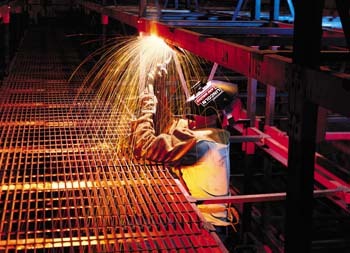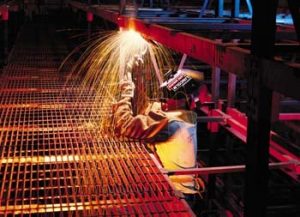Metal Fabrication
Weld Done
The ABCs of TIG, MIG, SW and other welding processes
Published
18 years agoon

If you’ve ever tried to join two pieces of metal while wearing a Darth Vader-like helmet, and left a line that resembled molten cat diarrhea, you know how much respect a good welder deserves. Anyone who has a command of metallurgy and inert gases, and also controls potentially hazardous equipment as deftly as a concert pianist, can afford to have a little attitude.
A welder helps sign companies construct, or retrofit, cabinet signs, among other tasks. Many small shops subcontract a certified welder to handle infrequent requests and installation, but larger, full-service companies, such as Las Vegas-based Vision Sign Inc., hire full-time welders to produce custom signs.
Trina Jarchow, Vision’s safety director, says the company’s welding staff helps her maintain quality and safety standards while also meeting stringent deadlines. However, the welder shares the affections of sign companies with other suitors, namely extrusion manufacturers.
Vulcan, the Olympian welder, may have forged Jovian thunderbolts and awe-inspiring armor, but extrusion manufacturers produce sturdy fare for standard-sized sign cabinets. Extrusion kits can be assembled quickly, and, thus, save fabrication time and cut costs.
Also, extrusions can move small- to medium-sized companies to unprecedented business levels. However, extrusions aren’t for every job, and modern welding techniques don’t require intense training — equipment and controls are more user-friendly. Even experienced operators were confused by numerous knobs on the control panel, and, therefore, welding-equipment manufacturers began producing simple, straightforward panels with one knob that sets weld parameters.
Systems now provide greater control and flexibility over voltage, pulsing and wirefeeding. Also, for quantity production, modern robotic welding cells are easier to program. Joel Lunsford of Lunsford Signs (Hot Sulpher Springs, CO) welds in-house. "We’re in the middle of nowhere in Colorado, three hours from a large city. So we do our own welding — actually we like to do it ourselves. We take pride in completing the fabrication and installation ourselves."
AdvertisementLunsford majored in graphic design in college and learned sign-fabrication techniques by working at a large sign company. He also took welding classes. "If you do it every day, it doesn’t take long to learn," Lunsford claims. "An hour’s worth of instruction will teach you the basics. To get certified, just take a few classes."
Pick MIG, TIG or stick? The American Welding Society recognizes more than 100 welding processes. That acronym-loving association has shortened most of the processes’ names to three- or four-letter abbreviations: OFC, OFCA, GMAW, GTAW, PAW, SMAW and OAW, to name a few.
Those acroynyms are accompanied by such subset acronyms as MIG and TIG. Two thousand years ago, blacksmiths and metalworkers forge-welded by heating and hammering metal until it fused together. Today’s welding processes developed a century ago when industrial demands spurred development of more efficient metalworking methods.
Oxyacetylene welding (OAW), which joins metals by heating with a torch, became feasible in the early 1900s, after acetylene was discovered. Equipment portability, precise heat control and low equipment cost endorse this old standby for joining thin materials in vehicles, plumbing and construction work. OAW is an oxyfuel welding (OFW) process — it uses oxygen and any fuel gas to produce one of the hottest welding flames.
Compare this to electric arc welding (EAW), in which a high-temperature electric arc melts metals, while additional molten metal can be added. The weldable item connects to one side of an electric circuit, and a metal electrode connects to the other side. When the two parts are brought together, and then separated slightly, the current jumps the gap and causes a continuous spark, or arc.
Faced with windy, outdoor conditions, many operators turn to an arc-welding process called shielded metal arc (or stick) welding (SMAW). When electric current from the constant-current power supply (which is usually direct current; the current isn’t shut off at each cycle, so the arc isn’t interrupted) hits the covered, consumable-metal electrode, an arc melts the electrode and base metals.
AdvertisementTiny metal globules form at the electrode’s tip and drip to the molten weld pool on the base metal. The SMAW electrode contains a solid or cast-metal core wire covered by a thick coating of flux, a material that hinders the formation of oxides or contaminants. Wire-fed welding processes use a continuous wire feed that serves as an electrode and filler material between two metal plates.
Gas metal-arc welding (GMAW), also known as metal inert gas (MIG) welding, incorporates a continuous solid-wire electrode for filler metal and an externally supplied gas (usually carbon dioxide or argon, or a combination) for shielding against oxidation. The welder positions the electrode wire to touch the base metal. When the welding gun is triggered, the continuous-voltage power supply activates, and voltage flows to the electric wire, striking an arc. The wire-feed mechanism feeds electrode wire from a spool through the welding gun and out the contact tip into the weld pool.
The MIG process, which is the only one that can weld all commercial alloys, produces long, continuous welds and very little splatter and slag. However, MIG can’t be performed in greater than 5-mph breezes. Gas tungsten arc welding (GTAW), also known as tungsten inert gas (TIG) welding, has become popular for high-quality, precision welding.
TIG welding forms an arc between a nonconsumable tungsten electrode and the base metal. Gas fed through the torch shields the electrode and molten weld pool; filler wire may be added to the weld pool separately. The process requires greater welder dexterity and eats up the electrode quickly.
Flux-cored arc welding (FCAW) uses a wire that, when burned by the arc, produces shielding gases and flux, without the need for an external shielding gas. The arc is forceful, but spatters. The weld is covered with a slag that usually needs to be removed. The FCAW process is recommended only on materials that are at least 20 gauge or thicker, and for outdoor procedures.
Stud welding (SW) permits rapid attachment of studs and other fasteners to a structure without piercing the metal. The power source is typically a capacitor-discharge supply. A stud is inserted into a stud gun, which is positioned perpendicularly to the welding surface. When the gun trigger is squeezed, an arc forms between the stud and the base metal, and the stud is lifted away from the plate.
AdvertisementAt the right time, the stud is plunged into the molten pool to form a weld. Voila — no holes. Neil Wilkinson, operations manager of International Welding Technologies Inc. (West Berlin, NJ), points out that stud welding is appropriate for attaching neon tubes, acrylic faces and stand-offs to cabinet signs,.
When sparks fly
A year ago, a spark from a welding torch started a 15-acre fire in Lake Piru, CA. Even if we focus on welding safety, some lessons seemingly demand a mistake. Welding generates heat and ignites such combustibles as rags or paper. Sparks and slag can travel long distances, so welding operators must maintain a minimum clear distance of 35 ft. from combustible material, or the material must be covered or shielded with metal or fire-resistant guards.
Faced with a rigorous OSHA review annually, Jarchow vigilantly oversees Vision Signs’ welding areas. "In regards to safety when welding, you must always keep in mind the equipment. It becomes dangerous when a person is ignorant to the hazards. Gloves, a proper welding hood, lenses and leathers are necessary equipment to use as well as maintain.
If an employee isn’t properly trained, the settings on the welder are too high, and the rod can burn too fast." And of course, don’t forget the hot-work permit, and don’t stand in water.
Companies Mentioned
International Welding Technologies Inc.
West Berlin, NJ
(856) 753-8126
Lunsford Signs
Hot Sulphur Springs, CO
(970) 725-3925
Vision Sign Inc.
Las Vegas
(702) 895-7474
SPONSORED VIDEO
Introducing the Sign Industry Podcast
The Sign Industry Podcast is a platform for every sign person out there — from the old-timers who bent neon and hand-lettered boats to those venturing into new technologies — we want to get their stories out for everyone to hear. Come join us and listen to stories, learn tricks or techniques, and get insights of what’s to come. We are the world’s second oldest profession. The folks who started the world’s oldest profession needed a sign.
You may like
Advertisement
Subscribe

Magazine
Get the most important news
and business ideas from Signsofthetimes Magazine.
Advertisement
Most Popular
-

 Tip Sheet1 week ago
Tip Sheet1 week agoAlways Brand Yourself and Wear Fewer Hats — Two of April’s Sign Tips
-

 Ask Signs of the Times2 days ago
Ask Signs of the Times2 days agoWhy Are Signs from Canva so Overloaded and Similar?
-

 Real Deal1 week ago
Real Deal1 week agoA Woman Sign Company Owner Confronts a Sexist Wholesaler
-

 Benchmarks4 days ago
Benchmarks4 days ago6 Sports Venue Signs Deserving a Standing Ovation
-

 Editor's Note2 weeks ago
Editor's Note2 weeks agoWhy We Still Need the Women in Signs Award
-

 Women in Signs1 week ago
Women in Signs1 week ago2024 Women in Signs: Megan Bradley
-

 Photo Gallery6 days ago
Photo Gallery6 days ago21 Larry Albright Plasma Globes, Crackle Tubes and More
-

 Product Buying + Technology2 weeks ago
Product Buying + Technology2 weeks agoADA Signs and More Uses for Engraving Machines












